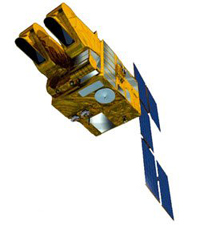SPOT (satellite)


SPOT (Satellite Pour l'Observation de la Terre) is a high-resolution, optical imaging Earth observation satellite system operating from space. It is run by Spot Image based in Toulouse, France. It was initiated by the CNES (Centre national d'études spatiales — the French space agency) in the 1970s and was developed in association with the SSTC (Belgian scientific, technical and cultural services) and the Swedish National Space Board (SNSB). It has been designed to improve the knowledge and management of the Earth by exploring the Earth's resources, detecting and forecasting phenomena involving climatology and oceanography, and monitoring human activities and natural phenomena. The SPOT system includes a series of satellites and ground control resources for satellite control and programming, image production, and distribution. The satellites were launched with the ESA rocket launcher Ariane 2, 3, and 4.
The company SPOT Image is marketing the high-resolution images, which SPOT can take from every corner of the Earth.
- SPOT 1 launched February 22, 1986 with 10 panchromatic and 20 meter multispectral picture resolution capability. Withdrawn December 31, 1990.
- SPOT 2 launched January 22, 1990 and deorbited in July 2009.
- SPOT 3 launched September 26, 1993. Stopped functioning November 14, 1997
- SPOT 4 launched March 24, 1998
- SPOT 5 launched May 4, 2002 with 2.5 m, 5 m and 10 m capability
The SPOT orbit
The SPOT orbit is polar, circular, sun-synchronous, and phased. The inclination of the orbital plane combined with the rotation of the Earth around the polar axis allows the satellite to fly over any point on Earth within 26 days. The orbit has an altitude of 832 kilometers, an inclination of 98.7°, and completing 14 + 5/26 revolutions per day.
SPOT 1, 2, and 3
Since 1986 the SPOT family of satellites has been orbiting the Earth and has already taken more than 10 million high quality images. SPOT 1 was launched with Ariane 2 on February 22, 1986. Two days later, the 1800 kg SPOT 1 transmitted its first image with a spatial resolution of 10 or 20 meters. SPOT 2 joined SPOT 1 in orbit on January 22, 1990 and SPOT 3 followed on September 26, 1993.
The satellite loads were identical, each including two identical HRV (High Resolution Visible) imaging instruments that were able to operate in two modes, either simultaneously or individually. The two spectral modes are panchromatic and multispectral. The panchromatic band has a resolution of 10 meters, and the three multispectral bands (G,R,NIR) have resolutions of 20 metres. They have a scene size of 3600km2 and a revisit interval of one to four days, depending on the latitude.
Because the orbit of SPOT 1 was lowered in 2003, it will gradually lose altitude and break up naturally in the atmosphere. Deorbitation of Spot 2 – in accordance with IADC (Inter-Agency Space Debris Coordination Committee)- commenced in mid-July 2009 for a period of two weeks, with a final burn on 29th July 2009. SPOT 3 is not working anymore either, due to problems with its stabilization system.
SPOT 4
SPOT 4 was launched on March 24, 1998 and features major improvements over SPOT 1, 2, and 3. The principal feature was the modification of the HRV, becoming a high-resolution visible and infrared (HRVIR) instrument. It has an additional band at mid-infrared wavelengths (1.58-1.75 micron), intended to provide capabilities for geological reconnaissance, vegetation surveys, and survey of snow cover.
SPOT 5
SPOT 5 was launched on May 4, 2002 and has the goal to ensure continuity of services for customers and to improve the quality of data and images by anticipating changes in market requirements.
SPOT 5 has two high resolution geometrical (HRG) instruments that were deduced from the HRVIR of SPOT 4. They offer a higher resolution of 2.5 to 5 meters in panchromatic mode and 10 meters in multispectral mode. SPOT 5 also features an HRS imaging instrument operating in panchromatic mode. HRS points forward and backward of the satellite. Thus, it is able to take stereopair images almost simultaneously to map relief.
SPOT 6 and SPOT 7
SPOT 6 and SPOT 7 form a constellation of Earth-imaging satellites designed to provide continuity of high-resolution, wide-swath data up to 2023. EADS Astrium took the decision to build this constellation in 2009 on the basis of a perceived government need for this kind of data. Spot Image, a subsidiary of Astrium, is funding the satellites alone and owns the system (satellites and ground segments).
- The architecture is similar to that of the Pleiades satellites, with a centrally mounted optical instrument, a three-axis star tracker, a fibre-optic gyro (FOG) and four control moment gyros (CMGs).
- SPOT 6 and SPOT 7 will be phased in the same orbit as Pléiades 1 and Pléiades 2 at an altitude of 694 km.
- Image resolution:
- Panchromatic: 1.5 m
- Colour merge: 1.5 m
- Multispectral: 8 m
- Spectral bands, with simultaneous panchromatic and multispectral acquisitions:
- Panchromatic (450 – 745 µm)
- Blue (450 – 525 µm)
- Green (530 – 590 µm)
- Red (625 – 695 µm)
- Near-infrared (760 – 890 µm)
- Footprint: 60 km x 60 km
- Responsive satellite tasking, with 6 tasking plans per day, per satellite
- Capacity to acquire up to 3 millions sq.km. daily
- Launches scheduled in 2012 and 2014 [2][3]
